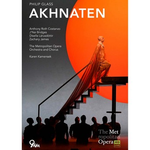|
Back
10/01/2021
Philip Glass: Akhnaten
Anthony Roth Costanzo (Akhnaten), J’Nai Bridges (Queen Nefertiti), Dísella Lárusdóttir ((Queen Tye), Zachary James (Anemhotep III, a professor)), Richard Bernstein (Aye), Aaron Blake (High Priest of Amon), Will Liverman (General Horemhab), Christian J. Conner (young Tutankhamun), Lindsay Ohse (Bekhetaten), Karen Chia-Ling Ho (Meretaten), Chrystal E. Williams (Maketaten), Annie Rosen (Ankhesenpaaten), Olivia Vote (Neferneferuaten); Suzanne Hendrix (Sotopenre), Metropolitan Opera Orchestra and Chorus, Donald Palumbo (chorus master), Karen Kamensek (conductor), Phelim McDermott (stage director), Tom Pye (set and projection designer), Kevin Pollard (costume designer), Bruno Poet (lighting designer), Sean Gandini (choreographer), Gary Halvorson (video director)
Recording: The Metropolitan Opera House, New York City (November 23, 2019) – 172’ (including bonus)
Orange Mountain Music OMM0193 (DVD and Blu-ray) – PCM Stereo/Dolby Digital 5.1 – Region Code: 0 – Picture format: 16:9 (Distributed by PIAS) – Booklet in English, Subtitles in English, French, German and Spanish

   
Director Phelim McDermott’s spellbinding production of Philip Glass’ opera Akhnaten was livestreamed from The Metropolitan Opera in late November 2019, and the film of that broadcast is now is available on DVD and Met on Demand platforms. And if you missed it onstage, the film experience is the next best thing starting with the knockout morphing production design by Tom Pye, in tandem with Kevin Pollard’s surreal costumes and Bruno Poet’s sculptural lighting.
McDermott’s visual storytelling in the style of tomb and temple artwork, with the principal cast members, moves through scenes in ultra-slow motion. Oh, and not to forget the ensemble of juggler-acrobats, Akhnaten astounds from every angle. Amazingly, the visuals are so well integrated as elements of the story that they don’t upstage the power of Glass’s music or conductor Karen Kamensek’s detailing, and, finally, there are lustrous performances of the singers led by countertenor Anthony Roth Costanzo as Akhnaten.
The libretto remains in the ancient languages and is meant to be sung untranslated. Glass collaborated with Shalom Goldman, Robert Israel, Richard Riddell and Jerome Robbins on the libretto. There are passages by Akhnaten from The Book of the Dead, passages by Akhnaten and other archives from his reign including Akkadian and Biblical Hebrew.
It tells the epic story of Akhnaten’s birth, ascension, marriage and spiritual awakening that caused wars. The tale is super condensed (even in its halting tableaux motion), but it is festooned with a troupe of jugglers/dance acrobats whose objects they keep aloft with the perpetual layers and trajectories of Glass’ score. The concept is not decorative, but very much a part of the narrative. In fact, it is a factual touchstone alluding to the first known images of jugglers that were discovered in Egyptian tombs.
Bass Zachary James portrays the spirit of Aten, Akhnaten’s dead father, and he fills in the historical context in English and in thundering classic orator style. Glass’s compositional signatures abound in Akhnaten: the swirling counterpoint dynamics, driving ceremonial drum matrix, the propulsive chorale, the overlays of brass and winds with sudden blazing intensity, hurling toward his off-the-cliff arrests or meditative enclaves. Meanwhile, vocally this work is in a category by itself, an orchestral-vocal dervish that hurtles through operatic sound barriers. A sometimes-cryptic stream of vocal scales, led by leads and choristers in bark clipped phrases and vocalization, have a sharp ritualized edge.
At the other end of Glass’s orchestral-vocal dervish is the meditation of Akhnaten’s “Hymn to the Sun” that comprises an entire scene at the end of Act II and is sung by Costanzo in English. The sun looms onstage, dwarfing the image of Costanzo as a heroic horn ushers him in, dressed in iridescent ceremonial robes that flow around him as he slowly moves over the stage. It is an arresting scene and a masterpiece aria for countertenor, and what Costanzo’s performance is, in a word, radiant.
Maestro Kamensek acknowledges that it is musically complex, but she has a Zen like approach to the breadth of Glass’s musical universe. Getting the players relaxed with Glass’s musical language and unique structures couldn’t be more impressive as she conjures the depth and delicacy of Glass’ profound score.
The obsession of Victorians over Egyptology (and a shade hurled at its cultural colonialism) as projected by a carnavale impresario, doesn’t really land. And some of the characters get short shrift, namely Nefertiti, especially after hearing mezzo-soprano J’Nai Bridges vocal chemistry with Costanzo in their love duet, that you want to hear more. But Bridges and Dísella Lárusdóttir, also a vocal powerhouse playing Queen Tye, make the most of their brief scenes.
The Met’s camera is mostly proscenium distanced, and slow pans and key close-ups are all smart, unfussy choices. The DVD/Blu-ray formats which include all of the interviews with Joyce DiDonato who engages with the designers, is not filler but fascinating, and her chats with conductor Kamensek and Anthony Costanzo are pure gold.
Lewis J. Whittington
|